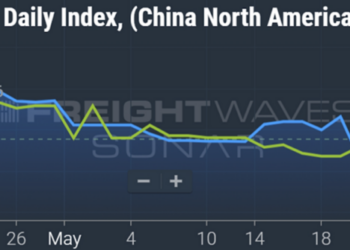Who is hauling cheap freight?
A recent survey by industry publication Overdrive looked into a question that is common among owner-operators: “Who is really hauling all the cheap freight?” The survey considered loads that are on the edge of or below a carrier’s profitability level. Asked if they ever hauled a load that lost money, a majority of the nearly 600 respondents said they had, while 38% said they had not.
Looking at reasons for taking unprofitable loads, most respondents fell into either repositioning into an area with better demand at 29% or getting home at 27%. Alex Lockie wrote, “The most commonly cited reasons for running at a loss were geographical, with ‘cheap freight’ chosen to get to a better-demand area or home most often. Add the ‘More than one of the above’ choice and geography might account for close to 80% of the total vote.”
The survey also included comments from respondents. To determine if a load is cheap, it helps to know one’s cost per mile. One commenter highlighted that challenge stating, “Almost every owner-operator in my segment of trucking that I’ve asked what their cost-per-mile to operate was looked at me as if I were growing a third eye right in front of them.” Other commenters felt they were facing unfair pressure from large fleets, which use their size and pricing power to squeeze owner-operators out of the marketplace. One respondent summed up the current freight zeitgeist, saying, “Last man standing who has deeper pockets, or is more efficient, or both.”
BMO Q2 data shows truck lending conditions worsen
(Photo: Jim Allen/FreightWaves)
Recent Q2 earnings data from one of the largest lenders in the trucking industry highlighted further deterioration in credit. According to BMO, the former Bank of Montreal, provisions for credit losses in Q1 climbed US$41 million, the highest level in its history since the bank bought the truck lending business from GE Capital in 2015.
One ongoing concern for BMO, whose transportation sector is 90% truck financing, is whether the original debt can be repaid. FreightWaves’ John Kingston writes, “Another key category, gross impaired loans, totaled $305 million, up from $230 million in the prior quarter. An impaired loan has been defined as one about which management believes there is significant doubt whether it can be repaid. The sequence at BMO for that category in the previous four quarters is $91 million, $113 million, $170 million and $230 million.”
Despite the challenges, Chief Risk Officer Piyush Agrawal remains optimistic, saying on BMO’s Q2 earnings call, “But a business like transportation, we’ve been in for 40 years, 50 years. We’ve been through several cycles. We managed through several cycles, and we’re beginning to see some recovery or flattening out of delinquencies out there.” Agrawal also provided more context on its transportation business risk exposure, saying the business is weighted more toward smaller fleets of 10 or fewer trucks.
Market update: Private fleet productivity stalls May For-Hire Trucking Index
ACT Research recently released its For-Hire Trucking Index, which highlighted how private fleet productivity is stalling the nascent freight market recovery. ACT’s indexes are composites, meaning a reading above 50 is an expansion and a reading below 50 is a contraction. The report notes this was most evident in the for-hire volume index, which fell 4.1 points seasonally adjusted to 41.7 points in April. The report notes evidence and anecdotes indicate private fleets poached for-hire freight.
Regarding how long this may last, the report is upbeat: “Given private fleets’ cost disadvantage, and lack of incentive for backhauls, we don’t expect this to last long, and recent Class 8 data suggests private fleet capacity additions are slowing, a welcome sign after an extended downturn.”
The driver availability index also declined, from 56 points in March to 51 for April. “Driver availability remains persistently elevated and far from a shortage, perhaps supported by older drivers sticking around to help with higher living costs, and perhaps by the rise in migration. We think pressure is likely to continue, and tightening in the driver market would help the recovery in rates,” said the report.
Fleet purchasing intentions also took a hit but were essentially flat month over month, with only 25% of respondents planning to buy equipment in the next three months. This is much lower than the 55.7% historical average. The report humorously adds, “Simply put: truckers don’t buy trucks when they aren’t making money. The low profitability environment has resulted in many large fleets cutting capex budgets by as much as 30-40%, with many delaying equipment purchases. When rates improve, purchasing sentiment should follow.”
FreightWaves SONAR spotlight: Spot market linehaul rates stay elevated after Memorial Day
(Source: FreightWaves SONAR)
Summary: Spot market linehaul rates remain elevated following CVSA’s International Roadcheck and the Memorial Day weekend, according to the FreightWaves National Truckload Index (Linehaul Only). NTIL is a seven-day moving average of daily spot market rates with an estimated fuel surcharge removed. The fuel costs are based on the average retail price of diesel fuel divided by 6.5 miles per gallon. In the past week, linehaul rates rose 1 cent per mile from $1.68 on May 20 to $1.69. The seasonal bump is a sign that the overcapacity, which weighed down linehaul rates in 2023, is abating. Compared to this time in 2023, spot market linehaul rates are 7 cents per mile or 4.32% higher.
Looking outside the spot market, the holiday weekend also saw contracted truckload capacity tighten as drivers returned home for Memorial Day weekend. Nationwide outbound tender rejection rates are approaching 5%, currently at 4.94% and the highest level since Feb. 12. The increase in tender rejection rates has been gradual, only 39 basis points in the past week from 4.55% on May 20 to 4.94%. Month over month, OTRI rose 165 bps from 3.29% on April 28 to 4.94%.
While dry van capacity responded to market events, seasonality is also impacting the reefer and flatbed segments. Produce season continues to see an increase in reefer outbound tender rejection rates, with ROTRI up 117 bps w/w from 7.44% on May 20 to 8.61%. Flatbed was also boosted by increased activity, partly from infrastructure and construction, with an increase of 14 bps w/w from 18.91% to 19.05%.
The Routing Guide: Links from around the web
Survey shows owner-operators and small fleets optimistic about demand (Commercial Carrier Journal)
Benchmark DOE/EIA diesel price drops for seventh straight week (FreightWaves)
‘Learned what worked’: Kenworth’s SuperTruck 2 improves freight efficiency by 136% (Trucking Dive)
Too many trucks for available freight keeps rates at unprofitable levels (The Trucker)
A peek at FMCSA’s new online registration system (Fleet Owner)
Metallica’s eco-friendly tour and the future of sustainable trucking (FreightWaves)
Like the content? Subscribe to the newsletter here.
The post Survey asks who’s hauling cheap freight appeared first on FreightWaves.













